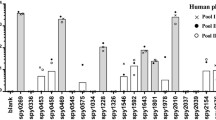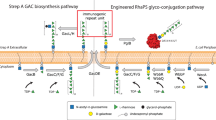Abstract
Streptococcus pyogenes (group A Streptococcus (GAS)) causes ∼700 million human infections each year, resulting in over 500,000 deaths. The development of a commercial GAS vaccine is hampered by the occurrence of many unique GAS serotypes, antigenic variation within the same serotype, differences in serotype geographical distribution, and the production of antibodies cross-reactive with human tissue that may lead to autoimmune disease. Several independent studies have documented a number of GAS cell wall-associated or secreted metabolic enzymes that contain neither N-terminal leader sequences nor C-terminal cell wall anchors. Here, we applied a proteomic analysis of serotype M1T1 GAS cell wall extracts for the purpose of vaccine development. This approach catalogued several anchorless proteins and identified two protective vaccine candidates, arginine deiminase and trigger factor. These surface-exposed enzymes are expressed across multiple GAS serotypes exhibiting ≥99% amino acid sequence identity. Vaccine safety concerns are alleviated by the observation that these vaccine candidates lack human homologs, while sera from human populations suffering repeated GAS infections and high levels of autoimmune complications do not recognize these enzymes. Our study demonstrates anchorless cell surface antigens as promising vaccine candidates for the prevention of GAS disease.




Similar content being viewed by others
References
Tart AH, Walker MJ, Musser JM (2007) New understanding of the group A Streptococcus pathogenesis cycle. Trends Microbiol 15:318–325
Carapetis JR, Steer AC, Mulholland EK, Weber M (2005) The global burden of group A streptococcal diseases. Lancet Infect Dis 5:685–694
Johnson DR, Kaplan EL, VanGheem A, Facklam RR, Beall B (2006) Characterization of group A streptococci (Streptococcus pyogenes): correlation of M-protein and emm-gene type with T-protein agglutination pattern and serum opacity factor. J Med Microbiol 55:157–164
Dale JB, Penfound TA, Chiang EY, Walton WJ (2011) New 30-valent M protein-based vaccine evokes cross-opsonic antibodies against non-vaccine serotypes of group A streptococci. Vaccine 29:8175–8178
Severin A, Nickbarg E, Wooters J, Quazi SA, Matsuka YV, Murphy E, Moutsatsos IK, Zagursky RJ, Olmsted SB (2007) Proteomic analysis and identification of Streptococcus pyogenes surface-associated proteins. J Bacteriol 189:1514–1522
Lei B, Mackie S, Lukomski S, Musser JM (2000) Identification and immunogenicity of group A streptococcus culture supernatant proteins. Infect Immun 68:6807–6818
Cole JN, Ramirez RD, Currie BJ, Cordwell SJ, Djordjevic SP, Walker MJ (2005) Surface analysis and immune reactivity of major cell-wall associated proteins of group A Streptococcus. Infect Immun 73:3137–3146
Aziz RK, Pabst MJ, Jeng A, Kansal R, Low DE, Nizet V, Kotb M (2004) Invasive M1T1 group A Streptococcus undergoes a phase-shift in vivo to prevent proteolytic degradation of multiple virulence factors by SpeB. Mol Microbiol 51:123–134
Walker MJ, McArthur JD, McKay F, Ranson M (2005) Is plasminogen deployed as a Streptococcus pyogenes virulence factor? Trends Microbiol 13:308–313
Walker MJ, Hollands A, Sanderson-Smith ML, Cole JN, Kirk JK, Henningham A, McArthur JD, Dinkla K, Aziz RK, Kansal RG et al (2007) DNase Sda1 provides selection pressure for a switch to invasive group A streptococcal infection. Nat Med 13:981–985
Lyon WR, Caparon MG (2004) Role for serine protease HtrA (DegP) of Streptococcus pyogenes in the biogenesis of virulence factors SpeB and the hemolysin streptolysin S. Infect Immun 72:1618–1625
McKay FC, McArthur JD, Sanderson-Smith ML, Gardam S, Currie BJ, Sriprakash KS, Fagan PK, Towers RJ, Batzloff MR, Chhatwal GS et al (2004) Plasminogen binding by group A streptococcal isolates from a region of hyperendemicity for streptococcal skin infection and a high incidence of invasive infection. Infect Immun 72:364–370
Ramachandran V, McArthur JD, Behm CE, Gutzeit C, Dowton M, Fagan PK, Currie B, Sriprakash KS, Walker MJ (2004) Two distinct genotypes of prtF2, encoding a fibronectin binding protein, and the evolution of the gene family in Streptococcus pyogenes. J Bacteriol 186:7601–7609
Batzloff MR, Yan H, Davies MR, Hartas J, Lowell GH, White G, Burt DS, Leanderson T, Good MF (2005) Toward the development of an anti-disease, transmission-blocking intranasal vaccine for group A Streptococcus. J Infect Dis 192:1450–1455
Batzloff MR, Hayman WA, Davies MR, Zeng M, Pruksakorn S, Brandt ER, Good MF (2003) Protection against group A Streptococcus by immunisation with J8-diphtheria toxoid: contribution of J8- and diphtheria toxoid-specific antibodies to protection. J Infect Dis 187:1598–1608
Guzmán CA, Talay SR, Molinari G, Medina E, Chhatwal GS (1999) Protective immune response against Streptococcus pyogenes in mice after intranasal vaccination with fibronectin-binding protein SfbI. J Infect Dis 179:901–906
Ji Y, Schnitzler N, DeMaster E, Cleary PP (1998) Impact of M49, Mrp, Enn, and C5a Peptidase proteins on colonization of the mouse oral mucosa by Streptococcus pyogenes. Infect Immun 66:5399–5405
Cole JN, Aquilina JA, Hains PG, Henningham A, Sriprakash KS, Caparon MG, Nizet V, Kotb M, Cordwell SJ, Djordjevic SP et al (2007) Role of group A Streptococcus HtrA in the maturation of SpeB protease. Proteomics 7:4488–4498
Sanderson-Smith M, Batzloff MR, Sriprakash KS, Dowton M, Ranson M, Walker MJ (2006) Divergence in the plasminogen-binding group a streptococcal M protein family: functional conservation of binding site and potential role for immune selection of variants. J Biol Chem 281:3217–3226
Beachey EH, Stollerman G, Chiang EY, Seyer JM, Kang AH (1977) Purification and properties of M protein extracted from group A streptococci with pepsin: covalent structure of the amino terminal region of type 24 M antigen. J Exp Med 145:1469–1483
Cole JN, McArthur J, McKay FC, Sanderson-Smith M, Cork AJ, Ranson M, Rohde M, Itzek A, Sun H, Ginsburg D et al (2006) Trigger for group A streptococcal M1T1 invasive disease. FASEB J 20:E1139–E1145
Gillen CM, Towers RJ, McMillan DJ, Delvecchio A, Sriprakash KS, Currie B, Kreikemeyer B, Chhatwal GS, Walker MJ (2002) Immunological response mounted by Aboriginal Australians living in the Northern Territory of Australia against Streptococcus pyogenes serum opacity factor. Microbiology 148:169–178
Brandt ER, Hayman WA, Currie B, Carapetis JR, Wood Y, Jackson DC, Cooper J, Melrose WD, Saul AJ, Good MF (1996) Opsonic human antibodies from an endemic population specific for a conserved epitope on the M protein of group A streptococci. Immunology 89:331–337
Fontán PA, Pancholi V, Noclari MM, Fischetti VA (2000) Antibodies to streptococcal surface enolase react with human a-enolase: implications in poststreptococcal sequelae. J Infect Dis 182:1712–1721
Degnan BA, Fontaine MC, Doebereiner AH, Lee JJ, Mastroeni P, Dougan G, Goodacre JA, Kehoe MA (2000) Characterisation of an isogenic mutant of Streptococcus pyogenes Manfredo lacking the ability to make streptococcal acid glycoprotein. Infect Immun 68:2441–2448
Degnan BA, Palmer JM, Robson T, Jones CED, Fischer M, Glanville M, Mellor GD, Diamond AG, Kehoe MA, Goodacre JA (1998) Inhibition of human peripheral blood mononuclear cell proliferation by Streptococcus pyogenes cell extract is associated with arginine deiminase activity. Infect Immun 66:3050–3058
Lyon WR, Caparon MG (2003) Trigger Factor-mediated prolyl isomerization influences maturation of the Streptococcus pyogenes cysteine protease. J Bacteriol 185:3661–3667
Yang X, Walters N, Robison A, Trunkle T, Pascual DW (2007) Nasal immunization with recombinant Brucella melitensis bp26 and trigger factor with cholera toxin reduces B. melitensis colonization. Vaccine 25:2261–2268
Ling E, Feldman G, Portnoi M, Dagan R, Overweg K, Mulholland F, Chalifa-Caspi V, Wells J, Mizrachi-Nebenzahl Y (2004) Glycolytic enzymes associated with the cell surface of Streptococcus pneumoniae are antigenic in humans and elicit protective immune responses in the mouse. Clin Exp Immunol 138:290–298
Rodreiguez-Ortega MJ, Norais N, Bensi G, Liberatori S, Capo S, Mora M, Scarselli M, Doro F, Ferrari G, Garaguso I et al (2006) Characterization and identification of vaccine candidate proteins through analysis of the group A Streptococcus surface proteome. Nat Biotechnol 24:191–197
Cole JN, Barnett TC, Nizet V, Walker MJ (2011) Molecular insight into invasive group A streptococcal disease. Nat Rev Microbiol 9:724–736
Carapetis JR, Wolff DR, Currie BJ (1996) Acute rheumatic fever and rheumatic heart disease in the top end of Australia’s Northern Territory. Med J Aust 164:146–149
Currie BJ, Carapetis JR (2000) Skin infections and infestations in Aboriginal communities in northern Australia. Australas J Dermatol 41:139–145
Cole JN, Henningham A, Gillen CM, Ramachandran V, Walker MJ (2008) Human pathogenic streptococcal proteomics and vaccine development. Proteomics Clin Appl 2:387–410
Pancholi V, Fischetti VA (1998) a-enolase, a novel strong plasmin(ogen) binding protein on the surface of pathogenic streptococci. J Biol Chem 273:14503–14515
Pancholi V, Fischetti VA (1992) A major surface protein on group A streptococci is glyceraldehyde-3-phosphate dehydrogenase with multiple binding activity. J Exp Med 176:415–426
Massell BF, Honikman LH, Amezcua J (1969) Rheumatic fever following streptococcal vaccination. Report of three cases. JAMA 207:1115–1119
Dale JB, Beachey EH (1985) Epitopes of streptococcal M proteins shared with cardiac myosin. J Exp Med 162:583–591
Acknowledgements and disclosure statement
The authors wish to thank M. Caparon for providing the HSC5 GAS strain, M. Kotb for providing the 20174 GAS strain, and B. Currie for providing Aboriginal serum. A.H. is a recipient of an Australian Postgraduate Award and a DAAD Research Grant for Doctoral Candidates, Young Academics and Scientists. A.J.C. is a recipient of a University of Wollongong Postgraduate Award. J.N.C. is the recipient of a National Health and Medical Research Council of Australia (NHMRC) Overseas Biomedical Fellowship. This work was supported by the NHMRC (M.J.W., B.K. and M.R.B.) and a DEST International Science Linkages Grant (M.J.W. and V.N.). B.K. and M.J.W. are NHMRC Research Fellows. The authors (A.H., E.C., J.N.C., C.M.G., V.R., K.S.S., I.Y.R.M., M.R.B., and M.J.W.) have an intellectual property or commercial interest in the antigens described in this study.
Author information
Authors and Affiliations
Corresponding authors
Electronic supplementary material
Below is the link to the electronic supplementary material.
Supplementary Table 1
Peptide mass fingerprinting identification of cell wall-associated proteins of S. pyogenes isolate 5448 and percent identity of cell wall-associated proteins with human homologs (PDF 60 kb)
Rights and permissions
About this article
Cite this article
Henningham, A., Chiarot, E., Gillen, C.M. et al. Conserved anchorless surface proteins as group A streptococcal vaccine candidates. J Mol Med 90, 1197–1207 (2012). https://doi.org/10.1007/s00109-012-0897-9
Received:
Revised:
Accepted:
Published:
Issue Date:
DOI: https://doi.org/10.1007/s00109-012-0897-9
Keywords
Profiles
- Victor Nizet View author profile




